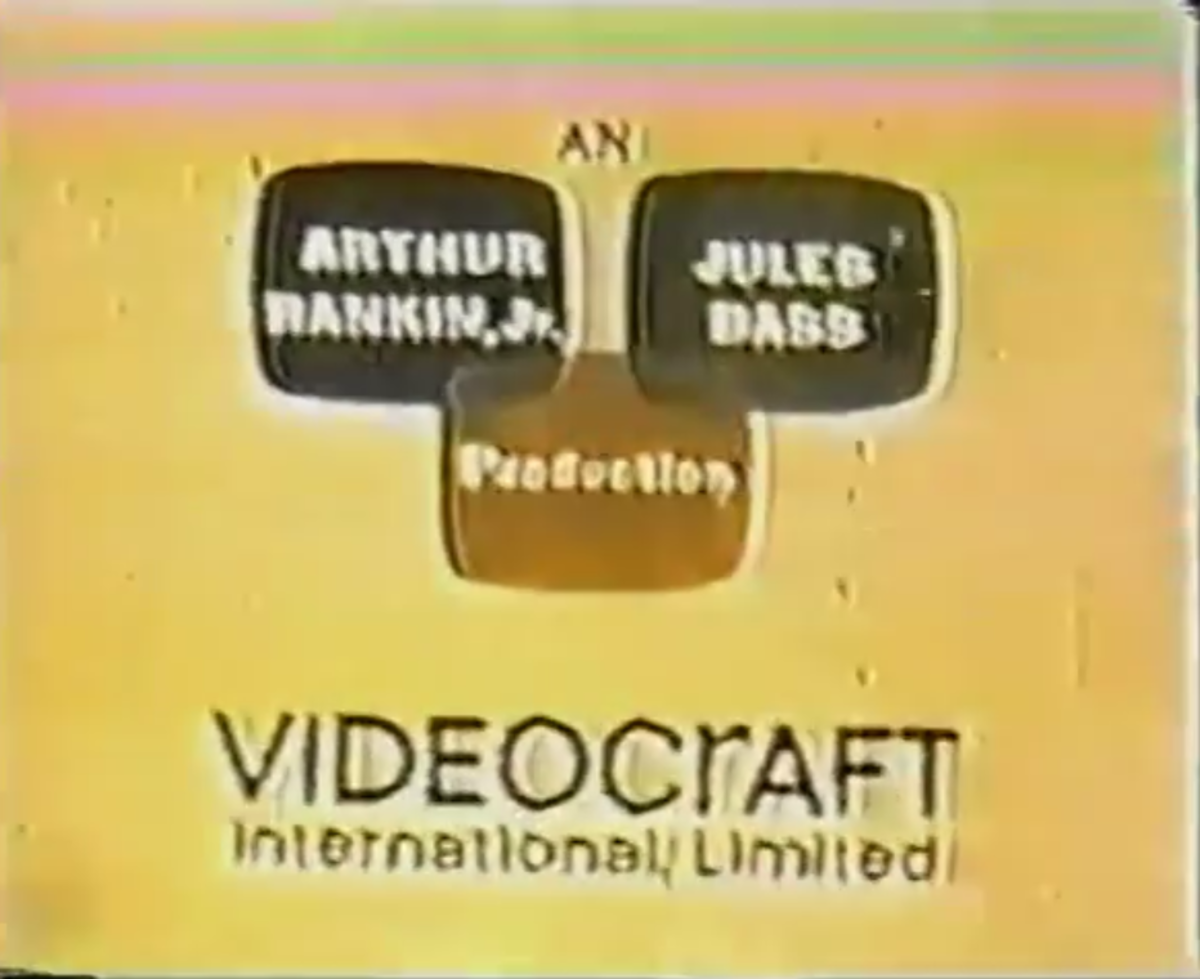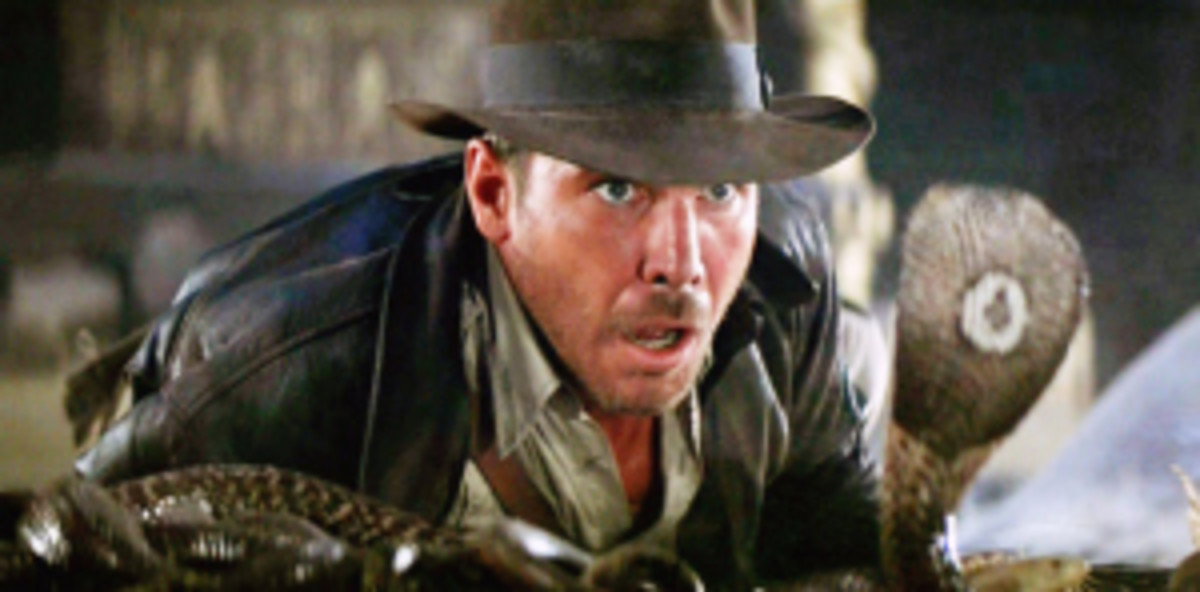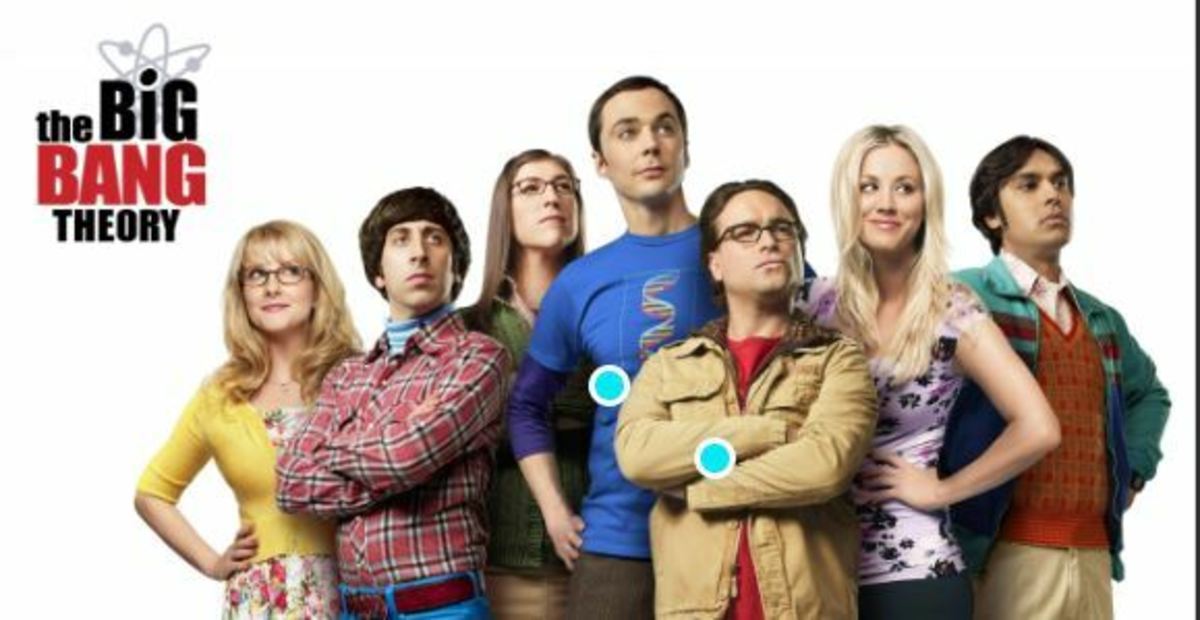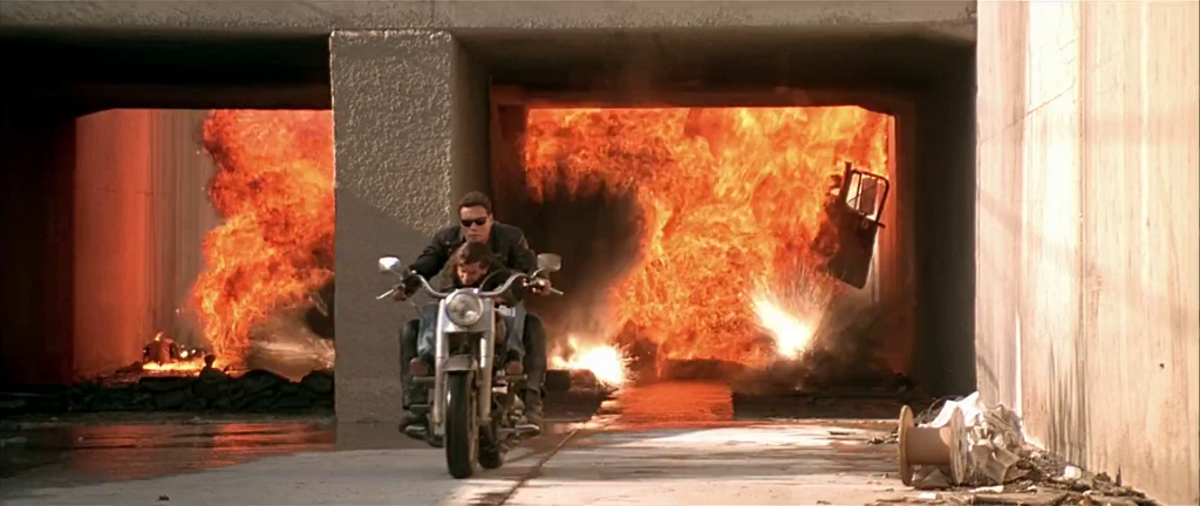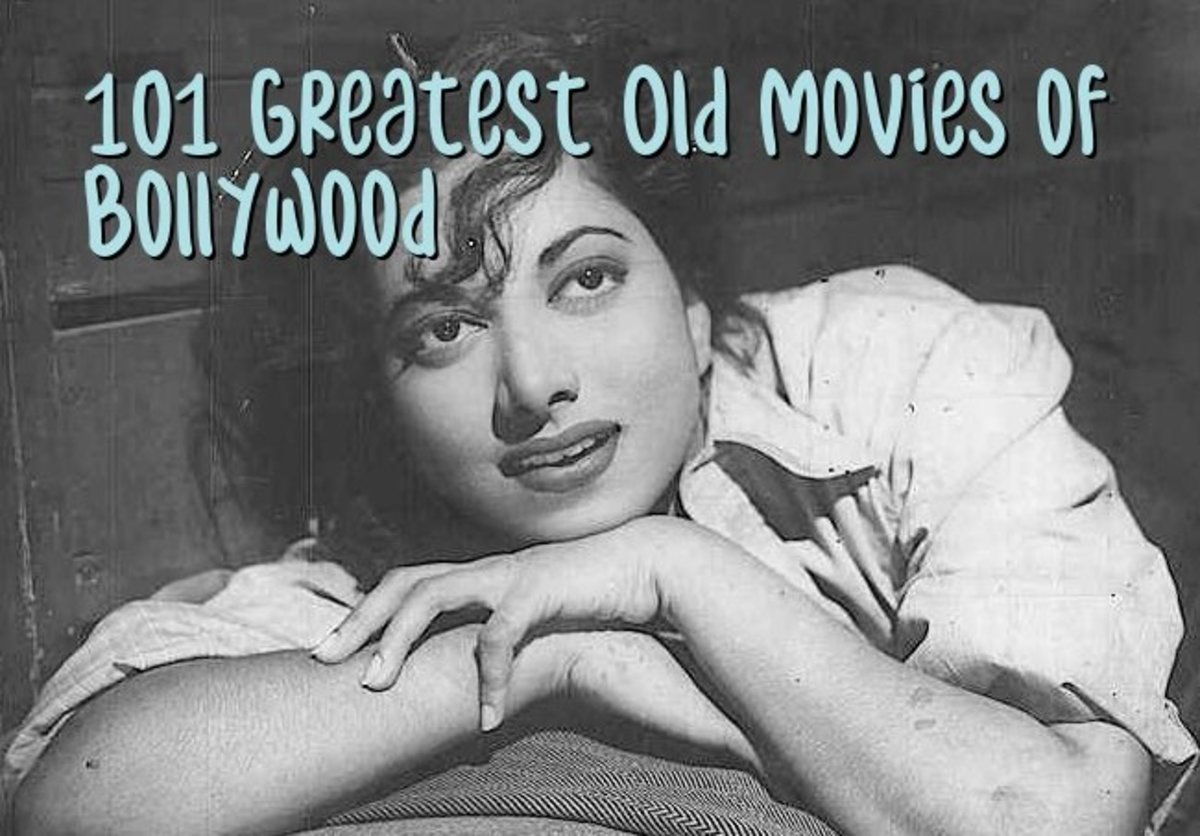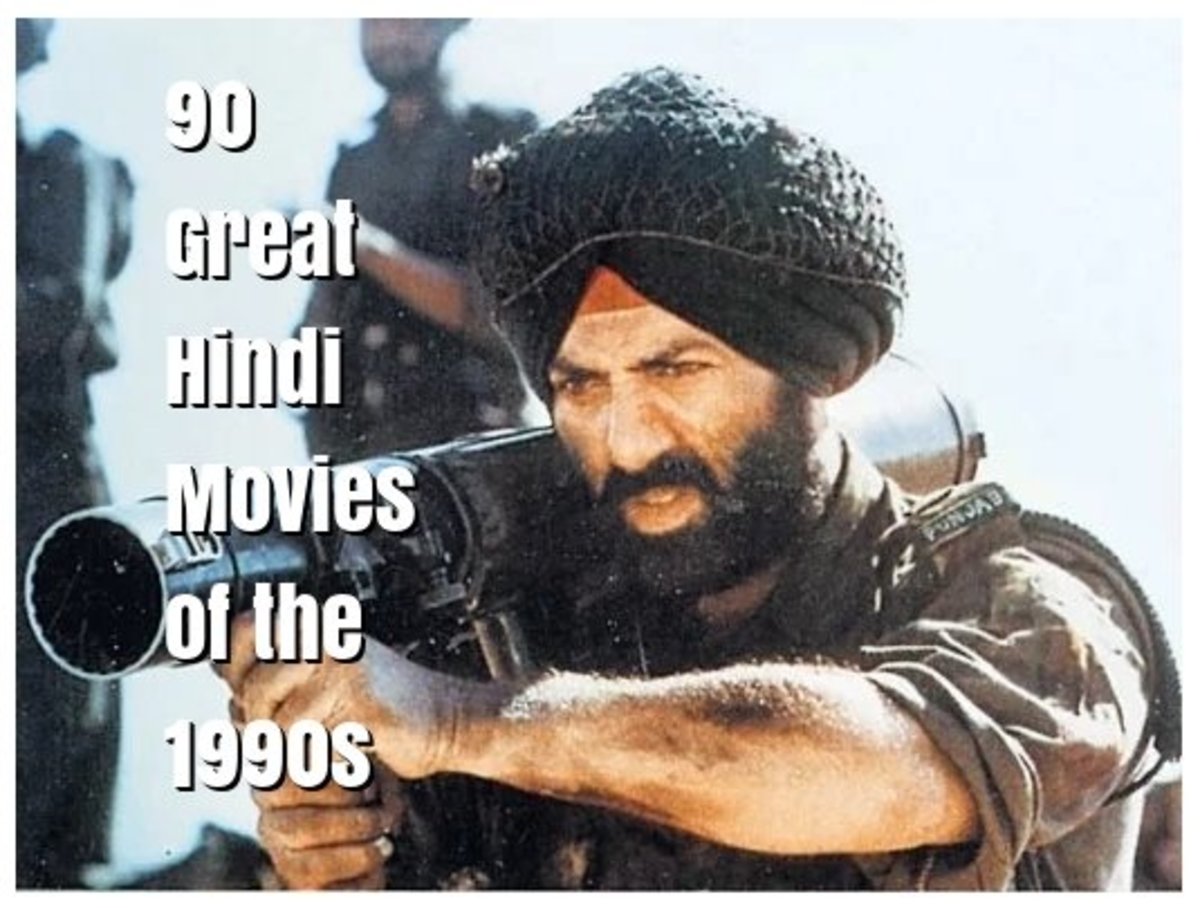The Ten Best Cgi Characters in Cinema

Cinematic provisions are the recipients of an attributed spectrum of avidly advocative fanatics and harshly contumelious critics, with both opposing factions hell-bent on the prevalent assimilation of their agenda of appreciative laudation, or condemning lamentation. There have been detractors who have taken umbrage with the astronomical ascension of the vaunted profile of the medium's prestige, as it has progressively been cultivated and assimilated into the beloving embrace of society on account of the so declared influence of “corruption” and “devolution” of the psychological cognitive function of the brain and the denotive resultant behavioural savagery and unsophistication-That admittedly, those lacking mental integrity could be impressionable enough to fall susceptible prey to meagre mercuriality in the composition of the conduction of their constitution, through the enticing and titillating hypnotism of the screen. But they remain in the drastic minority, and those alleged reservations have become an antiquated and ignorantly bigoted perspective.
In all veritable equity, there are dignified greats residing at a zenith of the epitomising echelons of a social zeitgeist culture. Purists in defence of the constant chastising of the merits of cinema from cynics would declare the bemoaning attitude of intolerance toward what they pride as virtuous as a manifestation of blasphemous heresy, intent upon nothing but slandering the image of the evolutionary advancements made in the realm of cinematic revelation. No matter how in contempt a detractor may be, what they cannot deny is the persevering persistence of an optimistic approach of ambition toward further innovations in that field.
The arguments over the primitive nature of film have commensurately transitioned themselves to a more subjective verdict on little more than unfavourable preference toward the semantic specifics of a particular picture, and the original arguments were largely rendered redundant and invalid by the exponential increase of emergent proficiency in filmmaking, and the development of skills and tools at the disposal of the almighty developers of the advantageous products that have been so ingratiating and alluring, that it has seen the creators of even minute elements of a broadly expansive overall property revered as visionary pioneers of exceptional excellence.
Endeavours voyaging forth into the mysterious curiosity of what creations and revelations could potentially yield has been the fuel spurring on the conviction and determination of the trailblazers of what has now been deemed popular culture, and precedents set by decades of aspirers of marvel and splendour have been the spearheading, precursive progenitors for tributary intellectual descendants to take cues from, interpret uniquely, and pay homage to in reverence. There have also been imitating plagiarists that have depreciated an otherwise unblemished reputation of the producers of such magnificent machinations, at least by way of the intent behind them, but they have been made absolutely irrelevant by the admirable aspects of the luminary contributors.
This entire dynamic principal has been constructed upon by attempts at deriving strategic procedures for implementation when fabricating a feature of fascination, that have proceeded both coherently and gone awry; As the process of fallacies is the only method of commission for the augmentative upgrade to a revolution in entertainment media as lessons learned. Perhaps the most exemplifying feature of them all is the groundbreaking innovation of post-production technological embellishments that have been utilised to promote a finalising piece of flair and finesse to the aesthetic appearance of the film. They are not the most integral aspects of a film, and it is the misappropriation of them that has culminated in a slew of misdemeanours and missteps in the ultimate product.
What even those who are the proponents of the incorporation of them will concede is the fact that the abuse of animation and synthetically rendered visuals in an oversaturation has been the largest detriment to the prominence of its inclusion and pandemic adulation undisputedly. Many would agree concurrently that the most appropriate and beneficial utilisation of the assets of ingenious technologies is sparingly and respectfully-Not precipitously, on the eatery naivety of the awe of possessing the possibility and leading to an offensive profusion of its eminence, or more deceptively with the intent of concealing inadequacies of the overall film. CGI and animation are incredibly divisive, as far as the cognisant regard of its perception goes, and the collective awareness of it is one of apprehension.
But for every fallacy that has been erroneously or unintentionally committed, there has been an equal volume of redeeming bastions for the salvation of the reputation of film CGI, and they sometimes are omitted from acknowledgement as the compensatory vindicators that they act as. Ten of the best alums representing the virtues of astute usage of CGI are allocated their due diligence in the following registry.

10. Neytiri(Avatar)
Neytiri(of the Na'vi clan within the film Avatar), is a committed, devoted stalwart of faith in the preservation of the conventions, lifestyle and welfare of all of those who she cares about. As the daughter of the leader of the Omaticaya faction, there is a burden of responsibility that she has versed herself in from an early age, and has acclimatised to taking the implicit trials and adversities in her stride. Passionate, defensive, noble and compassionate-She conceals her gentler constitutions beneath the external armour of stubborn feistiness and resilient defiance in the face of the most unfavourable odds.
She was an outstanding star of a film that has been responsible for the breakout mainstream eminence of 3D representation within filmography. And, although the intervening years since the revelation that was Avatar have been tumultuous with fluctuating degrees of success and proficiency in the divergent avenue of 3-Dimensional decadence, it is through no fault of Avatar that that state of condition has transpired. For better or worse, the film was an assured achievement of excellence on the resume of James Cameron, and the role that Neytiri played within the overarching plot of the conservative vigilant protection of her home, her people, and their collective identity in a conspiring effort with Jake, that could have easily been neglected as nothing other than the superficial love interest of the protagonist, was far more compelling and grounded with the weight and magnitude of intricate depth that rendered her more than just an accompaniment to the human hero. The film is just as much Neytiri’s tale of evolution to customary courtesies between species as it is Jake’s himself.
For a film that has suffered from the harshest critique of a superfluous over-extending runtime that hinders the longevity of the sustenance of the novelty, the character of Neytiri is one of the comprising features that doesn’t become fatiguing, both figuratively and philosophically through the composed conveyance of the nuances of her personality, and through the impressive visual rendition of the spectacular embodiment of her. The Na’vi are a peculiar species that are unorthodox and arcane in their foreign appearance, but also completely familiar in the constructs of their superstitions and principles within their tribes and their utilisation of tools. But the vibrancy of the deep blue of their skin was really accentuated through the animation, and with the most screen time of those of that species, Neytiri serves as a perfect emissary for the ambition of that accomplishment of the execution of it.

9. Yoda(Star Wars Episode II: Attack Of The Clones & Episode III: Revenge Of The Sith)
The Star Wars prequels have been lambasted with zeal and vitriol to a truly beleaguering degree, and the act of amassing a verbal arsenal of spite to asperse the films with has become such a rampant craze, that the merits of the films are almost completely disregarded by the detractors of them, and exaggerated to an irrational pinnacle of the pedestal in which they are placed upon by the advocates of them. One of the initially subtle, but exponentially significant and prominent topics of contention was what became of Yoda. A beloved and seminally admirable character of a nearly impeccable morality, but not without faults, has been an alum of monumental influence upon the plot of the saga(in life and in death) and the fans of the elaborate parables in their clamouring masses.
In his original appearances in the original trilogy(The Empire Strikes Back and Return Of The Jedi), he was a quirky, manically ingenious creature of gravitas and subdued wisdom, supported by the phenomenal puppeteer, Frank Oz. And this was a slightly altered, but maintained precedent during the events of The Phantom Menace, but in Attack Of The Clones and Revenge Of The Sith, the producers of LucasArts elected to render the tiny green giant with CGI. It was somewhat necessary for the spectacular duel with Count Dooku the featured in the penultimate phases of the commencement of the Clone Wars, and was met with initial hostility(the engagement with the Separatist leader was one of the most divisive sequences in the entire film), but the flaring tempers of taciturn fans in their ferocity was soon quelled by the consistency in the maintenance of the persona of the Grand Master of the Jedi Order, in all of his resplendent grandeur.
The decision to transition the graphical depiction of Yoda occurred at a time where the usage of CGI was at its most punctuated point of prevalence, to an extent that was obtrusive and inescapable, but that didn’t hinder the process of making his one of the few magnificent standouts among a breed of less than appealing peers. So many elements of controversy promised to prove the burdensome duty of animated a character that fans were more than satisfied with in his original appearance an exercise in futility, and a thankless task, but some have argued that his cameos in episodes 2 and 3 were more authentically faithful in their emulation of the puppet from 1980 than that of the clone in episode 1. The reputation of adoration and adulation has not been detrimentally affected by the languishing mediocrity of the prequels in which he starred, and that is partially a testament to the proficiency of the character in his persona and his expertise with a lightsaber and the force, and in the animation of his aesthetic.

8. Master Control Program(Tron)
The Master Control Program that emblazoned the prestige of the film Tron was a most intimidatingly and jarringly formidable and sinister antagonist that emanated as a delightfully maniacal pick of a bunch of iconic adversaries for the protagonists of the sundry of films that have ornamented the cinematic landscape. Although the embellishment of a scintillating-fi film, and consequently unsurprising that such a prominent character could be an omniscient supercomputer, but the fact that the creation of ENCOM founder Walter Gibbs and the improvement of Ed Dillinger was not only the product of their development, but the manipulative orchestrator of the subjugating enslavement of the programs of Flynn’s creation and Dillinger’s plagiaristic corruption.
It adopted the role of an autonomously ominous threat to both the virtual and the physical plain of the realities within the film, and that was the sole purpose of its function. A simplistic and basic function, one could argue, but it proved to be more than adequate in instilling an atmosphere of repressive and jeopardising perturbation through the aloofness of which the tenacious ferocity was approached with-Inherent traits to a quintessential machine, and the precise essence that asserted the looming menace that recurred intermittently through the distributed appearances throughout the film. It was both a virtue of the narrative and the character that made the eminence of the computer ephemeral enough to forget amidst the chaos of the remainder of the eventuations, but also saliently impactful enough to render the MCP a memorably enduring recollection of trauma for the witnesses to the exacted rage that brewed a recipe of destruction for the world of Tron.

7. Wall-E(Wall-E)
Pixar animation is a division of the Disney monolith that has been lauded with the highest regards for its consistency in the dissemination of compelling and endearing products that are universally digestive and engaging for a wide multitude of versatile and varied audiences, through the exuberant, euphoria that appeals to the youth, and the derivative analogous tones that are available for extrapolation in the endearment of more mature audiences. With a few sporadic exceptions, the international cinematic titan has amassed a fluid momentum that has propelled them to the pinnacle of pristine veneration for vintage and premier features of fantastical ecstasy in viewership, as per the consensus of the majority of the world. And the span of their reach of affecting impact and resonance within the core of the emotional fibre of the very being of their avid fanatics.
By the time of the release of the innocuous, but very assertively purposeful allegory of Wall-E, they had already been established as an epic production conglomerate for decades after a succession of insularly and intricately fabricated parables that have seen them lauded as the figureheads of a dynasty that has broadcasted its pedigree in full, flourishing display. But for that particular region of Disney’s studios, a tale with science fiction premises, that simultaneously were deeply rooted within the contemporary, real world had not been attempted with the same thrust of gusto that was invested into this film. There had been subtle allusions to the aura of the genre, and it was not the first film to feature a plot tailored to revolve around a robot. Across multiple production companies, there had been films that had garnered a deferred estimation of a spectacle to marvel at and to behold. Examples would consist of The Iron Giant, Bicentennial Man, Hitchhikers Guide To The Galaxy, and even the Transformers Movie.
But none had explored the pertinent and affronting issue of the negligence impacting the environment, and of the indolent laziness of the fine construction of transitioning the entire world into a vast vista of domesticated comfort that inevitably creates an adverse effect. The setting within a desolate, derelict dystopian parallel with the isolation of a mechanical construction that incorporates a sentient entity was a dubious inclusion for the catalyst for targeted crowds primarily comprised of juveniles, but it eventuated as a perfect metaphor to convey the imperative onus placed on the cognisance of the trajectory the human race is currently traversing. Wall-E himself perpetuated the precedent Pixar had set for immaculately depicting visual embodiments of a character of any ilk, and with extremely restrained dialogue, still managed to compel viewers to an investment and adoration for what was an adorable character. The purpose of Wall-E’s very existence was mediocre and mundane, but he found salvation through the companionship of a fellow robot, and eventually other humans, and sacrificed himself to physically save the humans from an impending doom, and simultaneously encapsulate a symbolic gesture of setting the hallmark standard of expectation to replicate. Few other synthetic creations within film managed to embody a sincere and compassionate soul the same way Wall-E did-Transcending preconceived notions of expectation of what other characters of his ilk would denote.
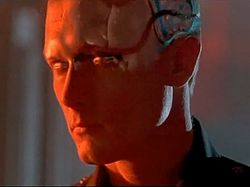
6. T-1000(Terminator 2: Judgement Day)
The T-1000 was the perfect stalwart custodian of everything purely tenacious and ferocious. It was a malignant machine hellbent on the eradication of the hope for all of humanity amidst the mire of the beleaguering war waged between the organic innovators, and the autonomous products of their own production company, SkyNet. The robots that exacted a furious storm of vengeance and devastation imposed upon humans were the perfect representatives for the inadvertent orchestrating of one’s own demise, and in the ensuing desperation, humans had to resort to the reliance upon the ingenious of the very scientists that created the rogue supercomputer production line to rectify the error, by reprogram precariously restrained Terminator machines, and send them back in time to ensure their own survival through the protection of their leader, John Conner, in his developmental years. SkyNet had impelled this course of action by attempting the same means, but the humans had prevailed in the preservation of the life of his mother before his birth, and coincidentally caused his conception.
It cost father, Kyle Reese, his life, and upon the second dastardly act of the artificial intelligence machine, there was a new, vastly improved adversary for a reprogrammed Terminator(in place of the human) to defend the now juvenile Connor against. The T-1000 was as imposing and threatening as the malignant intent behind its production; Mercurial, adaptive, agile, durable, and all but indestructible-It promised to cause nothing but relentless havoc and devastation to be left in its wake upon the induction of the formidable, titular “Judgement Day”. Such a catastrophic devastation was very nearly achieved through the machine’s ability to transmute into a liquid composition, and to transform into literally any physical manifestation its mechanical mind determined was the most efficient method necessary for the destruction of its nemesis. When in the form, the animation shone through, and while retrospectively the animation itself does not sustain the longevity of impressive rendering that it did upon release in 1991, the blank, expressionless impression of extreme commitment to its duty is what elevated the pedigree of the character, in addition to the superficially spectacular ability it had to create swords out of its limbs.
The machine was subconsciously audacious in the very overt attempt it made to jar audiences through the malicious and distressingly merciless brutality it inflicted upon everyone and everything in its path. And that is what really carried the characterless character to a summit of sensational esteem interspersed with fear that the experience of occupying the vicinity of the vicious force of something unnatural mandated.
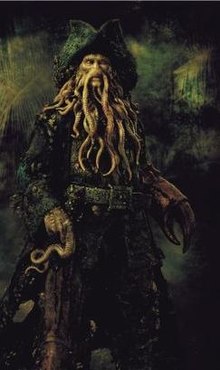
5. Davy Jones(Pirates Of The Caribbean: Dead Man's Chest & At World's End)
Davy Jones has been one of the few aspects the have really redeemed the oversaturated, meandering capitalisation upon the established image of an instituted intellectual property in the perspective of those who have become disillusioned by the abundance of the frequent recurrence of what initially was a refreshing and amusing instalment of a swashbuckling pirate genre film. He rode the wave of the franchise as it began to execute what many have deemed should have been the taking of a final bow of the property with an unbelievable degree of charisma and arresting presence, and was an antagonist that ingratiated himself through his tortured lineage of origin of sympathetically suffering means. The severity of the austere atmosphere of the tone surrounding him and his character arc was the distillation of personality that really strived to push the boundaries of permitted viscera and moroseness featured within a Disney film.
He was a subversively ruthless and brutal villain, but an honourable and cerebral oracle of wisdom in synchronicity, and the disunity of the contrasting conflict of those elements of the fibre of his personality were exactly what culminated in a complementary harmony that bolstered and assisted the retribution he sought to exact upon anyone not in subservience to him and his crew. He was a monstrosity of a hybridisation of a man and a squid, and the CGI depiction of the gruelling, slimy image(both literally and figuratively) of his distinguished head in its moist texture was the visual accompaniment of repellent horror to the personified reflection of an abhorrent being.
He besieged his enemies both intellectually and combatively, and although there was nothing especially groundbreaking about the imagery of his actions and semblance, the underlying quirks to his personality that concealed more than met the eye combined with the exceptionality of his distressing guise to infuse a dynamic and affronting impression left upon those enticed by the arresting eminence of a malignant force not to be reckoned with-Especially when he not only participated in, but was directly responsible for the chaotic pandemonium that transpired in his second featuring cameo. He had an aura of uncompromising perseverance about him that does CGI characters a great deal of justice, even when faced with the lack of favour for the pictures they star in, within some spheres of sceptics; And he is an undisputed redeeming virtue of those films, whatever one’s opinion of them is.
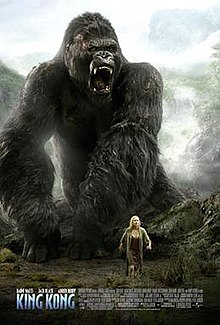
4. King Kong(King Kong)
King Kong is a hulking, monumentally enormous beast, that does rely largely upon the animation used to define his appearance on screen in order to convey the true gravity of his eminence on screen. The mythos around the character is spellbinding, and he has accomplished the remarkable feat of garnering investment and sympathy from audiences that revere him as the great, godlike gorilla that he is, despite the primitive way in which he conducts himself. There was a compelling bond of unity he managed to create with a human, in the contravention of the intolerant aspersions that were cast in his direction by the rest of her species. The fact that a dynamic of intimacy could be achieved by two being from vastly oppugnant, yet fundamentally identical cultures was a sight to relish and appreciate for the viewers that were willing to allow the 2005 remake of the original a due diligence.
King Kong was another tortured figure in the regard of his ostracisation from society, and the desire of his mere subsistence was so vague, at least to the high and might humans that condemned him, that is made his plight of defiance to the commissioned assault of his very being one of intrigue at how exactly either the indomitable force or the impervious object would prevail-A quandary that proved not too surfeiting, as evidenced in the permeating fascination furnishing the film. And by the standards of the mid 00s that are comparatively simplistic and shallow when contrasted against the divinity of the CGI of the present, what cannot be refuted about the picture is that fact that the delicate intricacy of the minutia of the fur of the almighty beast in the semantics of its sharp resolution, and the veneration behind its intent consolidated to form a passably satisfying final product.
There were no over embellished themes or allegories beyond those that were intrinsic to the original, and although there have been apprehensions about the continued exploitation of the prerogative for churning out interpretations of the source, it was popular enough to warrant another re-identification of the character and his fabled lore.

3. Woody(Toy Story, Toy Story 2 & Toy Story 3)
The charismatic and cocky cowboy that was the pride of his owner, Andy’s collection of toys, really spearheaded the purported plausibility of a genuine possibility that toys can come alive in the absence of their owners. A common childhood whimsy that was the appropriately implemented catalyst for the conveyance of more nurtured and cultivated themes. Woody was certainly the privileged recipient of unconditional affection and adoration from Andy, and that lead him to encompass his greatest asset of charming and fearless leadership and counselling guidance of his fellow toys, but for the fear of the insecurity that the sudden arrival of the alarmingly enchanting and chivalrous Buzz Lightyear. That impelled the consummation of the worst of his narcissism, as he plotted to proselytize the toy community into the alienation of the spaceman from the embrace of their compassion and mutual respect.
Another of the famed luminaries of Pixar studios’ production, that was largely responsible for their ascension to stardom from what, at the time of the release of the first film, were still relatively humble beginnings. And the evolution of the character into his initially reluctant, but eventually appreciative acceptance of and formulation of brotherly love with the astronaut was admirable and endearing; And when the additional exacerbation of staked affronted the group with the corruptive influence of the Al’s Toy Barn distribution group that coerced Woody into a false sense of security and belonging through the inviting manner of the polite and tender introduction of Jessie, Bullseye and the prospector that was later revealed to be more sinister, and then again when(after the accommodating admission of the cowgirl and her horse into their society) the group were confronted with the dilemma of conflicting loyalties to their original owner who had outgrown them and presented them with the paranoia of abandonment and again through the similar circumstances of the duplicitous charade orchestrated by the manipulative menace in the Lots O’ Huggin’ bear-Where it was the remainder of the group’s turn to be hoodwinked into a comfortable reception there before an unleash of tyranny and brutality, there was a blatant exploration of the location of ones own identity that was approached with more depth than is standard procedure in a family film.
That dimension grounded the film with the gravitas to allure on multiple tiers to all demographics of audiences, and suffused the films with longevity in a pandemic esteem among droves of fans, and Woody was the primary conductive emissary for the divulgence of the vitally pertinent gospel of profundity.

2. T-Rex(Jurassic Park)
The T-Rex from Jurassic Park is little more than a quintessential dinosaur, and doesn’t embody many behaviours that would see it defined as anything else. It is volatile, brutal, tenacious, and a fierce force of nature. But what does make the beast so incredibly eminent and outstanding amongst a sundry of candidates for selection as the most dignified masthead members of the prehistoric era is the narrative attributed to it and the implicit gravitas. The conceptual premise of Jurassic Park is a relatively simplistic one, but it was so intrinsically intriguing and curiously unprecedented, that it made the execution of it to the spectacularly amazing degree of quality that the niche fanbase of the fictional foray into the conservatory theme park for artificially bred dinosaurs determined it as somewhat resemblant of an elementary task of tranquillity. And that is certainly what the finalised product of the film purported the production process of the iconic picture to be.
In a generation where the realisation that a use of CGI would be a favourable piece of virtuous publicity to flaunt came to prevalence, the over saturation of attempts that failed to flatter audiences were already beginning to lead to an overwhelming consensus of fatigue and dissatisfaction. But the depiction of the scaly, pulsating, rampaging behemoth of the body of the T-Rex, as it gallivanted through the hub for hulking animals, tearing everything down and leaving disaster in the fallout of its reckless abandon, really injected a new lease of life into the cinematic technological revolution of the early 1990s, and emulsified an eclipsing shadow of phenomenal quality to be cast over all of its peers and competitors at the time.
The rendering of the creature was so groundbreaking in the foundational hallmark template setting it accomplished by subverting and abandoning the previous formula for animatronic representation of the beings featured in films before. And it was inadvertently responsible for the inspiration of a succession of plagiaristic tributaries that took the cues for their comparatively inferior animation abilities from Jurassic Park in an affectionate ode, but an inadequate emulation of the feats achieved by a film that is not culpable for the atrocities committed. But, as is necessary to reiterate, it was responsible-Through the seminal impact of influence and sustainable longevity still regarded as an effervescent epic today. The atmosphere exuded by the very presence of the beast was more than sufficient in beleaguering the protagonists of the story, but there was still some controversial apprehension in the considerations frequently discussed between them over whether to attempt to take precautionary action of impulsive violence out of fear; It granted a compelling dynamic directive of the moral ethics of the preservation of even the most threatening life.
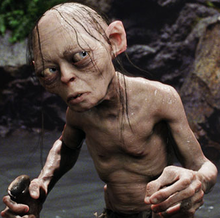
1. Gollum(The Lord Of The Rings: Fellowship Of The Ring, The Two Towers & Return Of The King)
Macabre, menacing, malevolent, savage, and predatory, among other aspects of an estranged and contorted persona-Sméagol, originally a Store Hobbit, fell victimised prey to the corruptive influence of the one ring of Sauron when he coincidentally encountered the sentient ornament of jewellery, and was manipulated into murdering his close friend in an eerily lustful desire for possession of his “precious”. Now the feral creature, Gollum, he was doomed to a life of servitude, worship and dissatisfaction with the unfulfillable demands of the ring, and languished in the torturous torment of simply being in its presence for centuries. He maintained an obsessive devotion to the maintenance of the pristine jewel piece, that defined the entirety of the fabric of his character and his actions, and his compulsion intensified to the degree of a ferocious and heathenish vitality in the vigilant preservation of the very object that was inundating his unhinged mentality.
All of his commitments and incentivised predilections came to a head when the loss of the ring during the events preceding the battle of the five armies, for the ironically coincidental fellow Hobbit, Bilbo Baggins, to sequestrate it within the dilapidated cave which had become his abode, impelled an immediate and impulsive sense of total despair within him. And most of the encapsulation of the magnificence of the character was courtesy of the immersive performance of Andy Serkis, who was also responsible for the motion capture of his CGI representation-Recorded precisely and ground-breakingly by the standards of the primitive and unrefined technological advancement of the early 00s for the Lord Of The Rings. The plausibility of the feral mannerisms of Gollum were represented most effectively through a distinguishably surreal harmony between the visual perspective of the character, and the insight into his person as well. His interactions with Frodo and Sam Wise in The Two Towers and The Return Of The King in particular exemplified the bipolar pendulum swing of the fluctuating personality of the warring consciousnesses-Sméagol, and Gollum, who both encompassed the moral righteousness, and the corrupted, beastliness of the little barbarian. The internal dispute between the entities in the iconic scene of self-torture granted fans the ambivalence of sympathy for, and resentment of him, for the virtuosity of the character’s innate composition and the malicious intent of the monster he had been transformed into. He is consequently exalted as not only one of the greatest CGI characters in all of film, but one of the best characters altogether.

